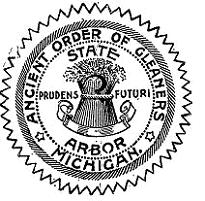
Ancient Order of Gleaners

The Gleaners was founded in 1894 in Cairo, Michigan, as a
fraternal insurance society for men and women over 16 "of good moral
character, who furnish satisfactory evidence of insurability" and who
"believe in the existence of a Supreme Being, the Creator and Preserver of
the Universe." When the order was first organized, it admitted only persons
who were actively engaged in farming, gardening, and related occupations or
small-town (up to 3,000 people) residents. These restrictions no longer apply.
There were 43,000 members in what is now the Gleaner Life Insurance Society in
1994, ten years later the society boasts a record high membership of 77,300
members in sixty-one active arbors (lodges).
The Gleaners took its name from the biblical book of Ruth and
was at first militantly committed to the values of rural and small-town America.
It would admit only people who were actively engaged in farming, gardening, or
like activities, or who lived in towns of under 3,000 people. It later changed
its rules, though, to admit anyone as defined above.
There are three classes of membership: Beneficiary, Junior
and Cooperative. Juniors can graduate automatically to Beneficiary membership by
staying in the organization for a certain period. "Cooperative"
membership is social membership, without financial benefits, but with fraternal
participation.
Although it has always been a beneficiary society, it
involved the following degrees: Introductory, Adoption, Ruth, and Dramatic.
The Introduction degree is required of all new members. After
a brief instruction the candidate takes an obligation promising to obey the
society, be faithful to the society’s principles, and not bring harm to any
members. The Adoption degree consists of lectures pertaining to the society’s
basic principles. A good portion of this degree’s moral instruction is drawn
from the Biblical story of Naomi, Ruth, and Boaz. (The reader probably recalls
that Ruth and her mother-in-law, Naomi, are gleaners mentioned in the Old
Testament.) Symbols of the initiatory degree are the sheaf, sickle, and
hourglass. The second degree (Ruth) appears to be a rite for women. It too draws
from the Book of Ruth in the Old Testament. The Dramatic degree ritual requires
the candidate to be hoodwinked. In part, this degree also points to Ruth, Naomi,
and Boaz; however, other items are also included. The outsider figure played by
the candidate for admission is a "Moabitish stranger."
The ritual employs a fair amount of religious symbolism. For
instance, the room where the Gleaners meet has an altar in its center; prayers
are spoken and hymns are sung. The ritual also contains an installation format
and a funeral ceremony.
The symbols draw on obvious sources; the emblems of the first
degree are the sheaf, sickle, and hourglass. Lodges are called Arbors; there
appears to be only two tiers, with the Supreme Arbor above the local lodge.
The Gleaners is very strong on the family, and, indeed, its
emblem shows an "ideal family" of father, mother, son, and daughter,
with the parent holding stalks of grain across which are the words "Prudens
Futur" which might best be translated as "thought for the
morrow."
The Gleaners is not particularly involved in charitable
works. The Gleaner blood bank operates at local Arbor level "as a health
guard to Gleaner members," and the organization stresses such all-American
activities as bowling, baseball, and square dancing. There are also "great
Gleaner picnics." The Gleaners provides for the orphans of deceased fellows
and also provides a number of college scholarships and loans. It encourages its
employees to study, reimbursing expenses to them.